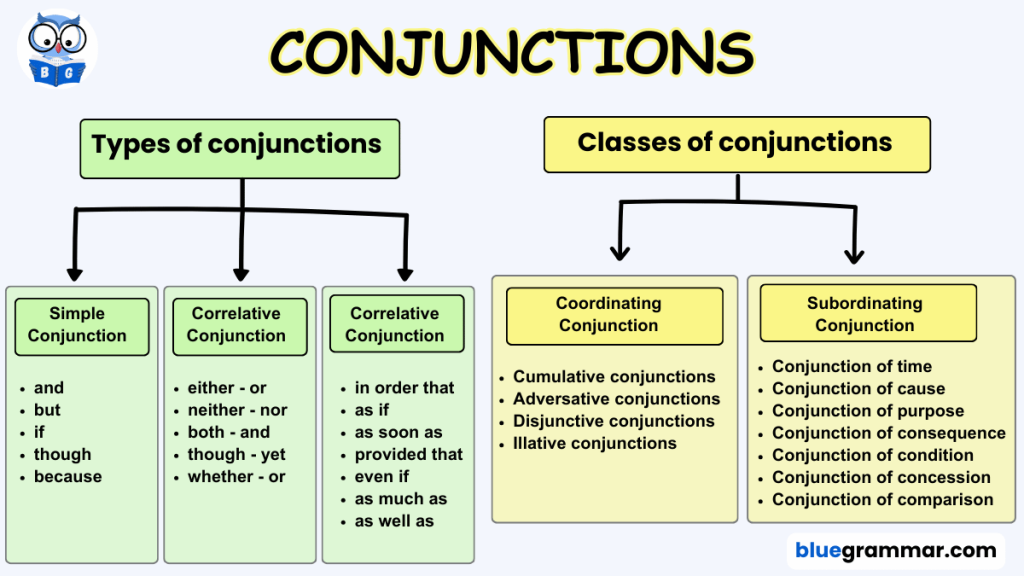
The word “conjunction” means union, concurrence, or coexistence. Let us look at the definition of conjunctions. Conjunctions are words that join sentences, clauses, and sometimes even words. These words help in making sentences more compact. Unlike relative adverbs and relative pronouns, conjunctions solely serve the purpose of joining and do not perform any other function. Look at the examples below to understand clearly:
- The teacher is young, but talented.
- Sara and Hania are sisters.
In the first example, the conjunction “but” joins two sentences while also making them more concise. Instead of saying, “The teacher is young, but she is talented,” we shorten it to make it more compact.
In the second example, the conjunction “and” simply connects two words.
Types of Conjunctions
There are three types of conjunctions: Simple Conjunctions, Correlative Conjunctions, and Compound Conjunctions.
1. Simple Conjunctions
Simple conjunctions are the most basic type, and they are commonly used to join words, phrases, or clauses.
Common Simple Conjunctions: and, but, or, nor, for, yet, so
Examples:
- I like coffee and tea.
- He is sick but still came to school.
2. Correlative Conjunctions
Some conjunctions are used in pairs. These are known as Correlative Conjunctions or simply Correlatives.
Common Correlative Conjunctions:
either – or, neither – nor, both – and, though – yet, whether – or, not only – but also
Examples in Sentences:
- Either do this or do that.
- Though it was raining heavily, yet she still managed to come.
Note: Correlative conjunctions should be placed right before the words they are joining.
Incorrect: She not only speaks English, but also Arabic.
Correct: She speaks not only English, but also Arabic.
3. Compound Conjunctions
Many compound expressions function as conjunctions. These are known as Compound Conjunctions.
Common Compound Conjunctions:
in order that, as if, as soon as, as well as, inasmuch as, provided that, even if
Examples in Sentences:
- The house looks as if it was built hundreds of years ago.
- You can have the sweets provided that you brush your teeth afterward.
- I accept your invitation, inasmuch as spending time with you is great.
Classes of Conjunctions
Conjunctions are divided into two main classes:
- Coordinating Conjunctions
- Subordinating Conjunctions
1. Coordinating Conjunctions
The word “coordinating” means “of equal rank.” Conjunctions that join together two sentences, clauses, or words of equal importance are called Coordinating Conjunctions. They connect two independent clauses.
Common Coordinating Conjunctions:
and, but, for, nor, or, also, neither – nor, either – or
Examples in Sentences:
- Dogs bark, and cats meow.
- I went to work, but my sister stayed at home.
Kinds of Coordinating Conjunctions
Coordinating conjunctions are further classified into four types:
Cumulative Conjunctions:
These conjunctions simply add one clause to another.
Examples:
- The cat got up and ran very fast.
- He plays the guitar as well as paints pictures.
Adversative Conjunctions:
These conjunctions indicate opposition or contrast.
Examples:
- He is ill, but he is getting better.
- She was fine; only she had a headache.
Disjunctive Conjunctions:
Also known as alternative conjunctions, these present two options or choices.
Examples:
- You must quit smoking, or you will get seriously ill.
- Revise your lesson; else you will fail the test.
Illative Conjunctions:
These conjunctions denote inferences.
Examples:
- Someone is at the door, for the bell rang.
- I have applied to multiple colleges, so I will definitely get admission.
2. Subordinating Conjunctions
Subordinating conjunctions join an independent clause to a dependent clause.
Common Subordinating Conjunctions: after, before, because, if, till, as, that, though, although, unless
Examples in Sentences:
- After the rain was over, the sun came out again.
- I will wait here till you return.
Types of Subordinating Conjunctions
There are many types of subordinating conjunctions.
Subordinating Conjunctions of Time:
These conjunctions are used to indicate the time of an action.
Examples:
- I went home after sunset.
- Hani reached the ceremony before it ended.
Subordinating Conjunctions of Cause:
Also called Conjunctions of Reason, Subordinating Conjunctions of Cause are used to show the cause and effect of something. They give the reason behind the happening of something. These are also called Conjunctions of Reason.
Examples:
- She baked a cake because it was her birthday.
- Since you have been gone, I have been doing the dishes.
Subordinating Conjunctions of Purpose:
These are the conjunctions which denote the purpose of things that: why something was done or why something happened.
Examples:
- He ate, so that he wouldn’t be hungry.
- I went to the doctor lest my wound should be infected.
Subordinating Conjunctions of Consequence
These conjunctions show the result of some happening. For this reason, they are also Conjunctions of Result.
Examples in sentences:
- She worked so many hours that she could barely sit.
- The seminar was boring so people started yawning.
Subordinating Conjunctions of Condition:
Subordinating Conjunctions of Condition are used to express that something will happen if some other thing is done. Or what will happen if the condition of one clause is fulfilled.
Examples:
- She will work if she gets paid handsomely.
- People will not succeed unless they work efficiently.
Subordinating Conjunctions of Concession:
These conjunctions concede or state a fact or idea regardless of what claim is made in the main clause. Look at the following examples to get clear on this one.
Examples:
- Though my cat is ill, yet it plays all day.
- Even though he was rich, he never looked down upon anyone.
Subordinating Conjunctions of Comparison:
These conjunctions show comparisons between two things, in two statements.
Examples:
- She is stronger than her friend.
- Our team wore white, whereas their team wore black.
By understanding these different types of conjunctions, you can enhance your writing and communication skills effectively!